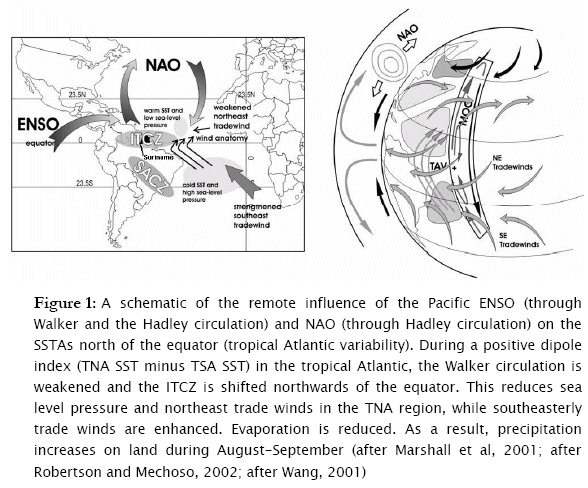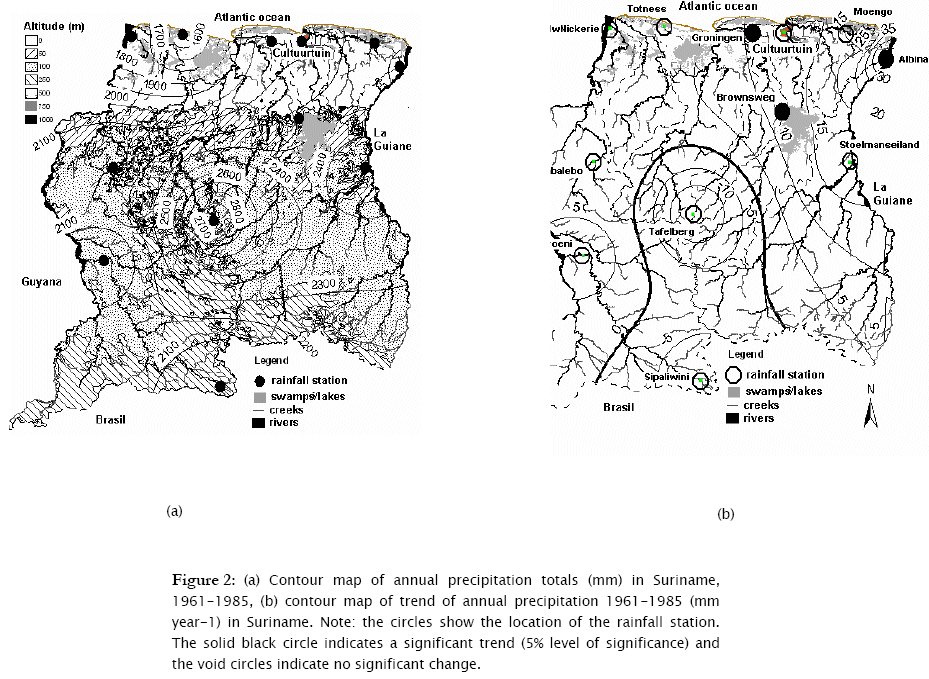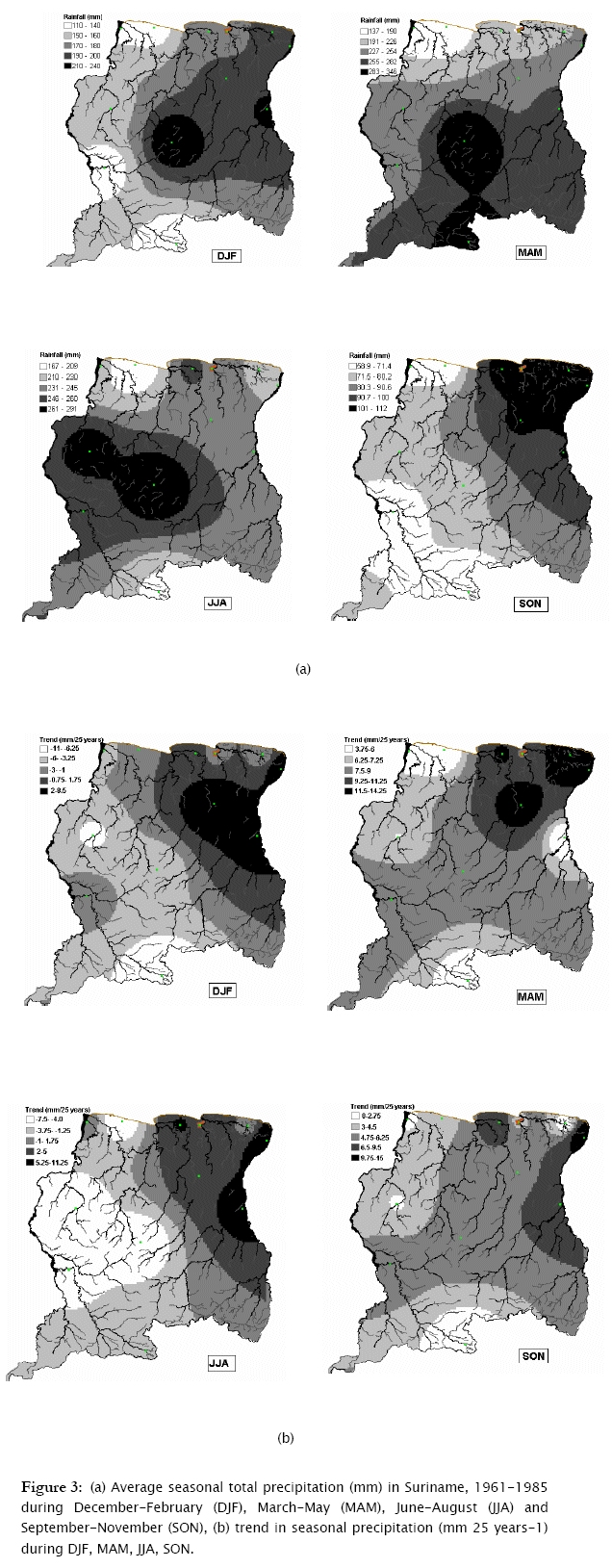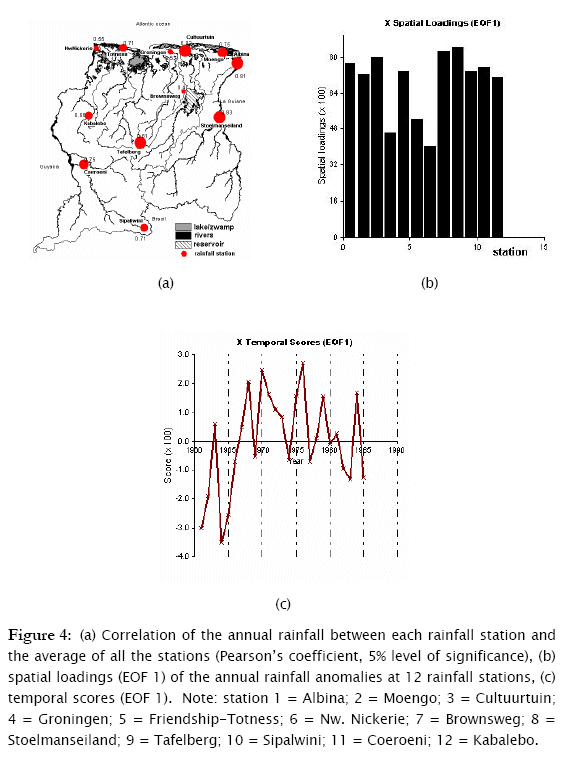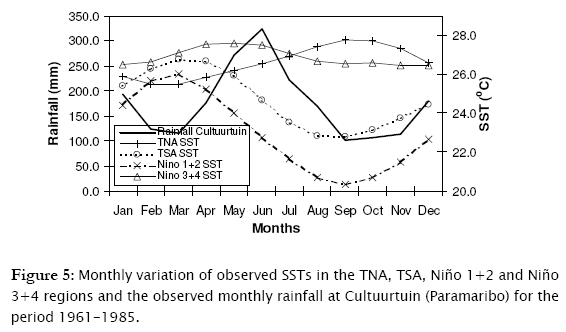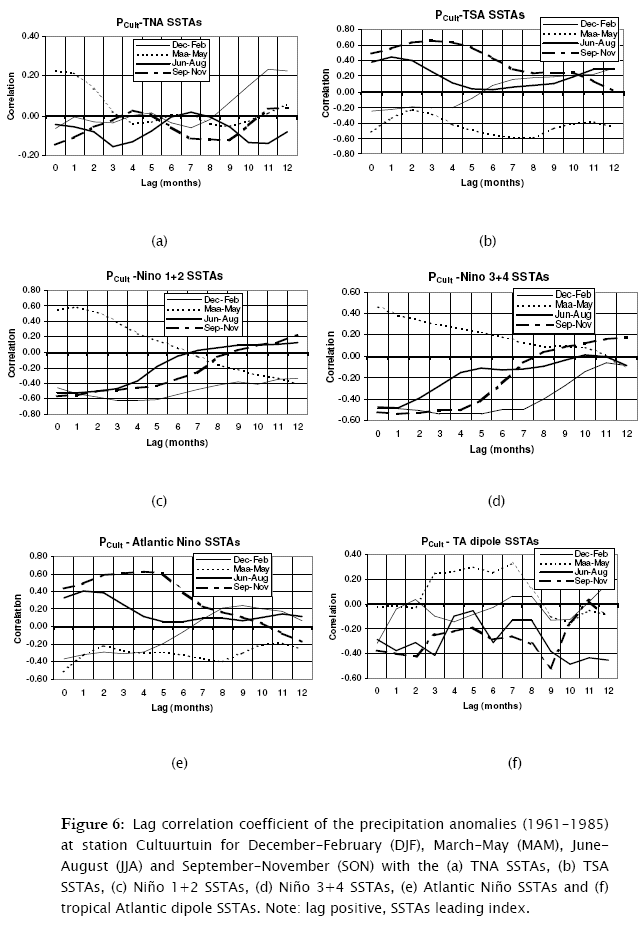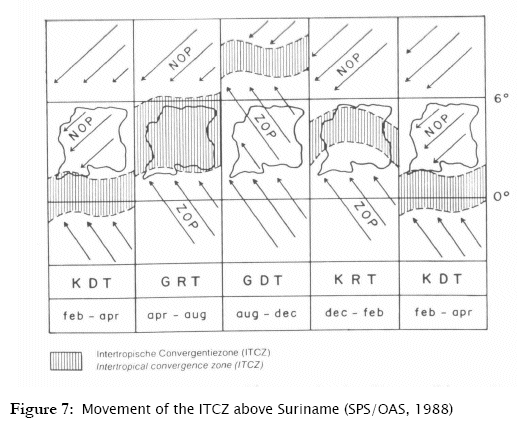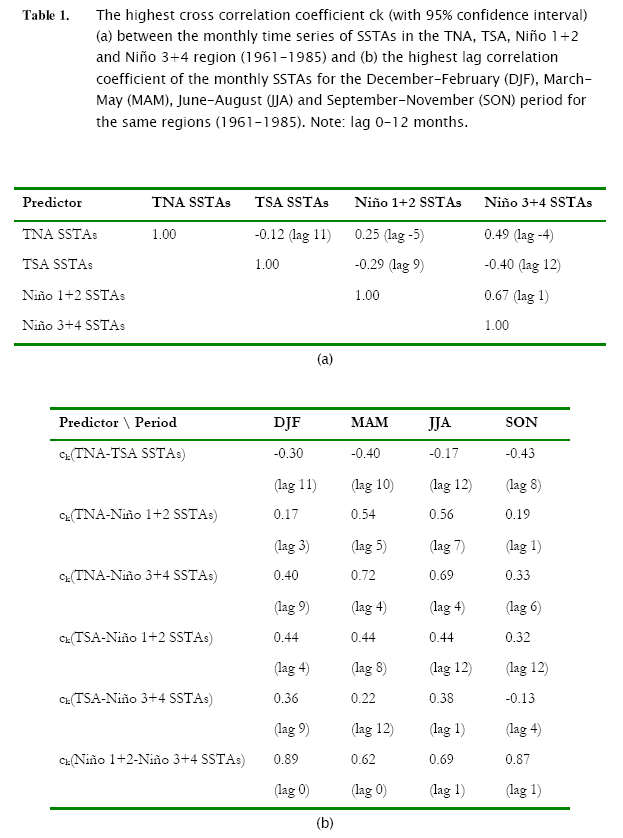Servicios Personalizados
Revista
Articulo
Indicadores
Links relacionados
Compartir
Acta Nova
versión On-line ISSN 1683-0789
RevActaNova. vol.3 no.3 Cochabamba dic. 2006
Artículo científico
Rainfall variability in Suriname and its relationship with the Tropical Pacific ENSO SST anomalies and the Atlantic SST anomalies
Riad Nurmohamed1, Sieuwnath Naipal1 And Cor Becker2
1Department of Infrastructure, Faculty of Technology, University of Suriname, Leysweg.
2Meteorological Service Suriname.
e-mail: r.nurmohamed@uvs.edu
Abstract
Spatial correlations (r) in the annual rainfall anomalies are analyzed using principle component analyses (PCA). Cross correlation analysis and composites are used to measure the influence of sea surface temperatures anomalies (SSTAs) in the tropical Atlantic and tropical Pacific Ocean with the seasonal rainfall in Suriname. It is shown that the spatial and time variability in rainfall is mainly determined by the meridional movement of the Inter-tropical Convergence Zone (ITCZ). It occurs that the rainfall anomalies are fairly uniformly over the whole country. The strongest correlation between the December-January rainfall (short wet season) at station Cultuurtuin is found with the SSTAs in the Pacific region and is about ck Nino 1+2 = 0.59 at lag 1 month. In March-May rainfall (beginning long wet season) there is a lagged correlation with the SSTAs in the Pacific region (clag 3 Nino 1+2 = 0.59). The June-August rainfall (end part of long wet season) shows the highest correlation with SSTAs in the TSA region and is about c = -0.52 for lag 0. In the September-November long dry season there is also a lagged correlation with the TSA SSTAs of about clag 3 = 0.66. The different correlations and predictors can be used for seasonal rainfall predictions.
Keywords: climate variability; El Niño; La Niña; rainfall; Suriname; statistical analyses; tropical Atlantic SST anomalies; Pacific Niño SST anomalies.
1 Introduction
Climate variability in north and northeast South America is, except for the orography, land-sea interactions and land processes, also linked to oceanic and atmospheric processes in the tropical Atlantic (TA) and the tropical Pacific. The most important phenomena on inter-annual to decadal time scale in this region are the Pacific El Niño-Southern Oscillation (ENSO), the Atlantic zonal equatorial mode (or the "tropical Atlantic Niño") and the tropical Atlantic meridional gradient (TAMG) (or the "tropical Atlantic dipole index") [3][6][9][8][12][13][19][20][21]. The above phenomena are caused by the variability in sea surface temperatures (SSTs), trough the anomalies in sea level pressure and winds [2]. The different mechanisms are schematically shown in Figure 1. Garzoli et al (1999), Giannini et al (2000), Marshall et al (2001) and Villwock (1998) have shown that the rainfall in northern South America is more related to the SSTAs in the tropical North Atlantic (TNA) than to the tropical South Atlantic (TSA) and the tropical Pacific ENSO.
The Pacific ENSO is one of the well-known phenomena that may cause floods and droughts in different parts of the tropics (10°S-10°N). It generally starts in March/April, reaches its peak between December and February and declines in March of the following year. The ENSO affect the TA through the Walker and Hadley circulation. The Walker circulation consists of air rising in the eastern Pacific, diverges eastward and sinks in the equatorial Atlantic and returns to the west. During the Hadley circulation, ascending air from South America moves from the tropical north Atlantic (TNA), descends in the equatorial Atlantic and flows southward to South America. When the SSTAs in the equatorial Pacific are positive (warm phase), the SSTs north of the equator becomes warmer, with a lag of 4-5 months, than the south of the equator. The Pacific Walker cell and the Atlantic Hadley circulations are then stronger and weaker respectively and this leads to a weakening of the northeast trade winds in the TNA and less surface evaporation [2][9]. The maximum SSTs in the TNA are reached during December-February and March-May [9][12][14][15][16][20]. During these periods, rainfall below normal is experienced in northern South America. During La Niña events, SSTAs in the equatorial Pacific are negative (cold phase). La Niña events reach its peak between June and September. Above normal precipitation is experienced during December-February and March-May in northern South America [1] [11] [18].
The Atlantic Niño is similar but weaker than the Pacific Niño. Most warm events of the Atlantic Niño (e.g. 1963, 1968, 1973, 1981, 1984, and 1987) occurred in August-September and a few in December-February [20]. During these events, the Atlantic Walker circulation is weakened and the easterly trade winds in the western Atlantic decrease. The Hadley circulation is strengthened and SSTs increase in the equatorial western Atlantic. Wang (2001, 2005) defined the tropical Atlantic dipole and showed that it is correlated with the north-south displacement of the ITCZ[21]. When the tropical Atlantic dipole becomes strongly positive (negative), rainfall decreases (increases) during December-February [2].
In this paper, an attempt is made to analyze the variability of the rainfall in Suriname and the relationship with the Atlantic and Pacific SSTs. The datasets used and the methods are described in section 2. Section 3 contains the results and discussions and section 4 the conclusions.
2 Data and methods
Twelve rainfall gauge stations distributed throughout Suriname that contain sufficient data are used to characterize the climate variability across Suriname (Figure 2). The meteorological data is provided by the Meteorological Service Suriname (MDS). For the classification of the spatial features of the annual cycle of rainfall (1961-1985) in Suriname, correlation analyses between the average of all the stations and each station are calculated, and principle component analysis (PCA) of the annual rainfall anomalies. PCA is calculated using the Climate Predictability Tool (v.5.04) of the International Research Institute for Climate Prediction IRI (http://iri.columbia.edu/ outreach/software/).
To investigate the relationship between the rainfall anomalies in Suriname and the Atlantic and Pacific SSTAs on inter-annual scale, cross correlation analyses and composites are used. For this purpose, only 7 rainfall stations are used. These analyses are carried out on seasonal scale (December-February DJF; March-May MAM; June-August JJA; September-November SON), using the Anclim model (Stipanek, 2003) and the KNMI Climate Explorer (http://climexp.knmi.nl/). Monthly observed SSTs (1950-2003) are adapted from the National Oceanic and Atmospheric Administration [10] for the tropical northern Atlantic-TNA (5.5°-23.5°N, 15°-57.5°W), the tropical southern Atlantic-TSA (0°-20°S, 10°E-30°W), the Extreme Eastern tropical Pacific ENSO-Niño1+2 (0°-10°S, 90°-80°W) and East Central Pacific ENSO-Niño 3+4 (5°N-5°S, 160°E-150°W). The monthly Atlantic Niño SSTAs (3°S-3°N, 20°W-0°) and SSTAs in the tropical Atlantic ("dipole index") are obtained from Dr. Wang, C. (NOAA). The Atlantic dipole is defined as the difference between the SSTAs in the TNA (5.5°-23.5°N, 15°-57.5°W) and the SST anomalies in the TSA (0°-20°S, 10°E-30°W) [20]. Reanalyzes of fields (1961-1985) from the Natural Centers for Environmental Prediction-National Center for Atmospheric Research (NCEP-NCAR) are also used to investigate the correlation between seasonal rainfall and SSTs. For the uniformity and availability of statistical tables, all statistical tests in this study are performed at a 5% significance level.
3 Results and discussion.
3.1 Variability of rainfall
Figure 2 (a) shows the distribution of the annual precipitation (1961-1985) based on twelve rainfall stations. A main feature of the precipitation distribution is that the annual precipitation is the highest in the mountainous area of Suriname (center of Suriname: about 2800 mm) and the lowest in the low-lying areas (northwest Suriname: about 1650 mm). Figure 2 (b) shows that a decrease in annual precipitation occurs in the center and southwest of Suriname (5-10 mm year-1). Northeast Suriname shows the strongest increasing trend (10-35 mm year-1). Three stations in this area show a significantly positive trend in this area. Figure 3 (a) shows the average seasonal total precipitation and Figure 3 (b) the seasonal trends for DJF, MAM, JJA and SON. These results indicate that the season rainfall distribution has the same pattern as the annual rainfall distribution. A decrease (increase) in seasonal rainfall during 1961-1985 is observed in east (west) Suriname during DJF and JJA. During MAM and SON positive trends are observed over the whole of Suriname. Figure 4 (a) shows that there is a relatively high correlation (r > 0.60) between the rainfall stations. The PCA results (Figure 4b) also show that the annual rainfall anomalies tend to occur fairly uniformly across the whole country (positive loadings and about similar weights at most stations). The first principle component represents 51% of the total variance in the data, which can be explained by the weak correlation at Brownsweg (0.47), Nw. Nickerie (0.55) and Groningen (0.57). Figure 4 (c) shows the inter-annual variability with the temporal scores from which can be concluded that 1964 was a very dry year and 1976 a very wet year. In the next paragraph the seasonal spatial variability of rainfall will be discussed further.
3.2 Relationship between rainfall anomalies and Atlantic and Pacific SSTAs
Figure 5 shows the observed monthly SSTs in the Atlantic and Pacific regions and the monthly observed rainfall at station Cultuurtuin. The monthly rainfall shows a seasonal cycle, which is caused by the meridional movement of the Inter-tropical Convergence Zone (ITCZ) [4]. Most of the other rainfall stations also show a similar seasonal rainfall pattern. The monthly rainfall is the highest in May-June and the lowest in October-September.
Figure 6 shows the lagged correlation (Pearson's coefficient) of the DJF, MAM, JJA and SON precipitation anomalies at station Cultuurtuin with the SSTAs in the TNA, TSA, Niño 1+2, Niño 3+4, Atlantic Niño and the TA dipole region. Because of the fact that all the rainfall stations show similar results, only station Cultuurtuin will be used further in this study. During December-February (the short wet season), the TNA is less warmer than normal and the TSA is warmer than normal (Figure 5). Northeasterly trade winds north of the equator are strengthened, while the southeasterly trade winds south of the equator are weakened [19] [22]. In DJF, the precipitation anomalies show a much stronger correlation with the SSTAs in the Niño 1+2 region (clag 3 = -0.63), followed by the tropical Atlantic Niño region (clag 0 = -0.36) and the TA region (clag 0 = -0.32). A positive lag indicates that the SSTAs is the leading index and a positive (negative) correlation indicates that large (small) precipitation anomalies are related with large SSTAs. Correlations with the SSTAs in the TNA region (clag 11-12 = 0.23) and the SSTAs in the TSA region (clag 3 = -0.24) are lower (Figure 6 (a), (b), (f)). During DJF, the ITCZ has a small rainfall belt and is displaced southward of Suriname and causes a reduction in precipitation across Suriname (Figure 3b) that reaches its peak during February-March. February-March is the short dry season.
During April-mid August (the long wet season) the TNA (TSA) becomes warmer (colder) than normal indicating a northward movement of the ITCZ. Oceanic air rises over the TNA warm water, easterly trade winds from the Atlantic Ocean are weakened north of the equator and easterly trade winds south of the equator increase. The southeasterly trade winds also bring the tropical heat sources of the Amazon to Suriname. Evaporation increases over the TNA and as a result precipitation increases over northern South America. During this period, the ITCZ has a rainfall belt that is twice the rainfall belt during DJF and hardly covers the whole of Suriname. The extension of this season compared to the small wet season is due to the fact that the ITCZ collides with the relief of the country (near Tafelberg) as well with the south and northeast trade winds, which causes its movement to become slower. This explains the high rainfall in the center of Suriname (Figure 3b). During the beginning of the long wet season (MAM), the Niño 1+2, TSA and the tropical Atlantic Niño SSTAs show all a strong correlation with the rainfall anomalies in the same order of magnitude of about clag 1Nino1+2 = 0.59, clag 0TSA= -0.52 and clag 0 Atlantic Nino = -0.52, than with the TNA SSTAs (clag 0 = 0.23) and the TA dipole SSTAs (clag 7 = 0.33) (Figure 6). During JJA, the SSTAs in both the TA dipole and TSA region show a stronger correlation with the rainfall anomalies than in the other regions of clag 10 = -0.49 and clag 0 = -0.52 respectively.
From mid-August to November (the long dry season), the SSTs in the TNA (TSA) are the highest (lowest) and the precipitation maximum has passed over Suriname and is found north (5-10ºN) above the Atlantic Ocean [22]. During this period, the trade winds south of the equator increase surface winds and cause surface evaporative cooling and, as a result, less rainfall above Suriname (Figure 3b). The rainfall anomalies show the largest positive correlation with the SSTAs in the TSA region (clag 3 = 0.66) and the Atlantic Niño region (clag 4 = 0.63) than in the other regions. The annual movement of the ITCZ above Suriname is schematically shown in Figure 7.
Cross correlation analyses have shown (Table 1) that the Pacific Niño 3+4 SSTAs shows a stronger correlation with the TNA SSTAs during all the seasons compared to the Niño 1+2 SST. The highest correlation is reached in MAM and is 0.72 for k = 4 months. In the TSA region, the Niño 1+2 SST is slightly stronger correlated with the SST than the Niño 3+4 SST. The highest correlation (ck = 0.44) is obtained when the Niño 1+2 SSTAs lead the TSA SSTAs by 4, 8 and 12 months in DJF, MAM and JJA respectively. Similar results were also found by Wang (2001) and Marshall et al (2001).
4 Conclusions
Analysis of spatial variability of rainfall (1961-1985) has shown that there exist a medium to high correlation in the annual rainfall variability (1961-1985) between the different stations: 0.47 at Brownsweg up to 0.83 at Stoelmanseiland. A decreasing trend in annual precipitation occurs in central and southwest Suriname (maximum -14.5 mm year-1), while a rising trend is observed in the other areas of Suriname. The highest negative trend is in northeast Suriname and is about 42.7 mm year-1. The highest rainfall occurs at all the stations in May-June and the lowest rainfall in October-September.
Statistical analyses of rainfall in Suriname show that rainfall correlate well with SSTAs in the TNA, TSA, Niño 1+2, Niño 3+4, Atlantic Niño and the TA dipole region. Based on station Cultuurtuin, the highest correlation (ck = -0.63) between the DJF rainfall (short wet season) is found with the Pacific SSTAs in the Niño 1+2 region three months earlier. The MAM rainfall anomaly (beginning long wet season) correlate with the TA SSTAs (clag 0 TSA = -0.52; clag 0 Atlantic Nino = -0.52) as well as with the Pacific SSTAs (clag 1 Nino 1+2 = 0.59). The highest correlation between the JJA rainfall (long wet season) and the SSTAs is reached in the TSA region and is about c = -0.52 for lag 0. Finally, the long dry season (SON) is stronger correlated with the TSA SSTAs (clag 3 = 0.66). For all seasons it is found that the rainfall is also medium to highly correlated with the Pacific SSTAs, which indicates that El Niño events may cause rainfall below or above normal (drought conditions). The correlation with the Niño 1+2 SSTAs is stronger during DJF (clag 3 = -0.63), followed by MAM (clag 1 = 0.59), SON (clag 0 = -0.57) and JJA (clag 0-1 = -0.52).
The knowledge of rainfall variability and processes responsible for this variability, among other things, is used to provide scenarios that can be used for water resources planning and design of hydraulic works. At present, forecasting the Atlantic climate variability and the Pacific ENSO with respect to rainfall need to be further examined. More research is needed to advance our understanding of the tropical oceanic and atmospheric processes, the interactions and the mechanisms of variability in Suriname and surrounding countries.
5 Acknowledgements
This work was partially financially supported by the Research and Development Fund of the University of Suriname. The main author would like to thank Chunzai Wang, Giannini Alessandra and Geert van Oldenborgh for their cooperation. Three anonymous reviewers provided valuable comments that helped improve the manuscript.
References
[1] Acevedo, M.; McGregor, K.; Andressen, R.; Ramirez, H.; Ablan, M. 1999. Relations of climate variability in Venezuela to tropical pacific SST anomalies, 10th Symposium on Global Change Studies, America Meteorological Society, preprints pp: 81-84, Annual Meeting, Dallas, TX.
[2] Ambrizzi, T.; de Souza, E. B.; Pulwarty, R. S. (2005) The Hadley and Walker regional circulation and associated ENSO impacts on South American seasonal rainfall, In: The Hadley Circulation: present, past and future, Diaz, H.F. and Bradley, R.S. (eds), 203-231. Kluwer Academic Publishers, Netherlands.
[3] Berlage, H.P. 1957. Fluctuations of the general atmospheric circulation of more than one year, their nature and prognotisc value, Koninklijk Nederlands Meteorologisch Instituut, Mededelingen en Verhandelingen 69. pp 152.
[4] Emanuels, J. 1968. Klassificatie der seizoenen, serie 2 no 6, Meteorologische Dienst, Ministerie van Bouwwerk, Verkeer en Waterstaat, Suriname. pp. 1-14.
[5] Garzoli, Z. ; Enfield, D. et al. 1999. COSTA, Climate observing system for the tropical Atlantic, Workshop Miami, May 4-7, 1999. http://www.aoml.noaa.gov/phod/COSTA/ (Retrieved July 16, 2004).
[6] Gianninni, A.; Kushnir, Y.; Cane, M. 2000. Interannual variability of Caribbean rainfall, ENSO and the Atlantic Ocean, J. Climate 13-297-311. [ Links ]
[7] Intergovernmental Panel on Climate Change (IPCC). 2001. Climate Change 2001: the Scientific Basis, Albritton, D. and Allen, M. et al (eds). WMO/UNEP, Zwitserland. pp.1-98.
[8] Martis, A.; van Oldenburg, G.J; Burgers, G. (2002) Predicting rainfall in the Dutch Caribbean – more than El Nino?, Int. J. Climatol. 22: 1219-1234.
[9] Marshall, J.; Kushnir, Y.; Battisti, D.; Change, P.; Czaja, A.; Dickson, R.; Hurrel, J.; McCartney, M.; Saravanan, R.; Visbeck, M. 2001. North Atlantic Climate Variability: phenomena, impacts and mechanism, Int. J. Climatol. 21: 1863-1898. [ Links ]
[10] NOAA-CIRES Climate Diagnostics Center. 2004. Climate Indices: Monthly Atmospheric and Ocean Time Series. http://www.cdc.noaa.gov/ClimateIndices/ (Retrieved August 7, 2004). [ Links ]
[11] Obasi, G. 1999. The 1997-1998 EL Niño event: a Scientific and Technical Retrospective, WMO/UNECSO/UNEP/ICSU, Switzerland. pp.1-96. [ Links ]
[12] Rajagopolan, B.; Kushir, Y.; Tourre, Y.; Cane, M. 1997. Temporal Variability of North Atlantic Oscillation and Tropical Atlantic SST, Lamont-Doherty Earth Observatory of Columbia University, New York. [ Links ]
[13] Robertson, A; Mechoso, C. 2002. Links between the American Ocean and the South American Climate Variability, CLIVAR Exchanges No 25.
[14] Ropelewski, C.F.; Halpert, M.S. 1987. Global and regional precipitation patterns associated with the El Niño/Southern Oscillation, Mon. Wea. Rev, 115, 1606-1626. [ Links ]
[15] Ropelewski, C.F.; Halpert, M.S. 1989. Precipitation patterns associated with the high index phase of the Southern Oscillation, J. Climate, 2, 268-284. [ Links ]
[16] Ropelewski, C.F.; Halpert, M.S. 1996. Quantifying Southern Oscillation-precipitation relationships, J. Climate, 9, 1043-1059. [ Links ]
[17] SPS/OAS. 1988. Suriname Planatlas, National Planning Office of Suriname and Organization of American States, Washington D.C. [ Links ]
[18] Turner, J. 2004. The El Niño-Southern Oscillation and Antarctica, Int. J. Climatal. 24. pp.1-31.
[19] Villwock, A. 1998. Clivar Initial Implementation Plan. www.clivar.com/publications/othre_pubs/iplan/iip/pd2.htm (Retrieved March 27, 2004). [ Links ]
[20] Wang, C. 2001. Atlantic climate variability and its associated atmospheric circulation cells, Int. J. of Climate 15: 1516-1536. [ Links ]
[21] Wang, C. 2005. ENSO, Atlantic climate variability, and the Walker and Hadley circulations, In: The Hadley Circulation: present, past and future, Diaz, H.F. & Bradley, R.S. (eds), 173-202. Kluwer Academic Publishers, Netherlands.
[22] Webster, P. J. (2005) The elementary Hadley circulation, In: The Hadley Circulation: present, past and future, Diaz, H.F. & Bradley, R.S. (eds), 9-60. Kluwer Academic













